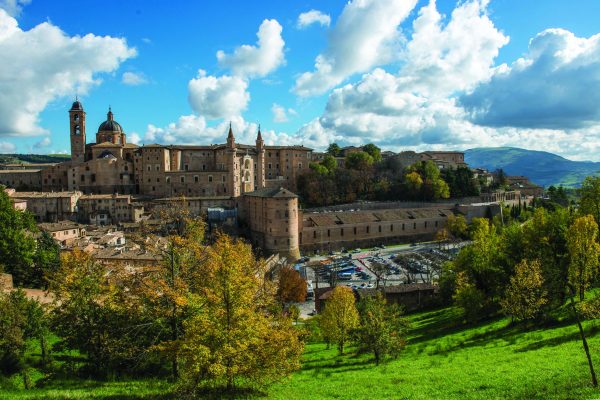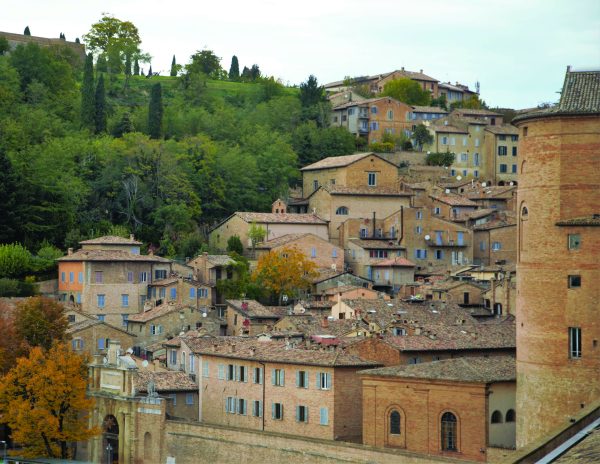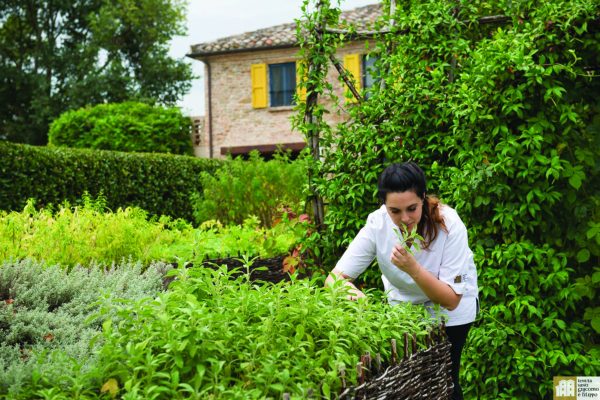The Marche region has a glittering coastline, verdant hills, majestic mountains, and a trove of artistic treasures – Chris Allsop explains why your first cultural stop should be Urbino.
Images by Val Nicastro

The typical line trotted out about Le Marche – the fertile region between the Adriatic and the Apennines, between forested Abruzzo and foodie-heaven Emilia-Romagna – is that it’s “Tuscany without the crowds”.
As a rule for the region, neither part of this assessment is accurate. The rolling hills of Le Marche’s central region are certainly redolent of its westerly neighbour, but Le Marche is much more rustic, and its population centres much smaller (the region has less than half the population of Tuscany).
And as for the crowds… Hordes of Italians come here in the summer, though they are usually confined to the coast. But where the assessment does work is with the northern city of Urbino. This UNESCO World Heritage city is a Renaissance treasure, much like Florence or Siena – though it is markedly less crowded than either. Here you’ll find luminous works of art, interesting history, and wonderful restaurants.
1. Tour the historical centre
Urbino is an impressive sight. The medieval centre, arrayed across a pair of hills, is still entirely enclosed within its city walls. Out of it rises the composed turrets of the Ducal Palace – the former seat of Federico da Montefeltro, who hauled Urbino up into medieval significance. Within its walls, the entirely brick-paved streets run helter-skelter, gutters scored down their middles. Blue-grey shutters adorn the buildings and bars set out their tables with the legs cut to allow level drinking on steep streets. A walk along the walls at night, with the views into the surrounding countryside, is incredibly atmospheric. Along the way you’ll encounter the monument to Raphael, his likeness elevated on a marble plinth in Piazza Roma. Head into the centre’s heart to seek out an aperitivo in Piazza della Repubblica, which, with the city’s student population, is never dull.
2. Explore the medieval quarter
It feels like all of Urbino is the ‘medieval quarter’, however there is a knot of alleyways that is officially labelled as such. It’s a fabulous warren to explore, with its intact medieval architecture and subsequent tiny rooms. One of the city’s great artistic treasures also has lodgings here, within the unassuming entrance to the Oratorio di San Giovanni Battista. Inside this intimate place of worship your attention is captured by the floor-to ceiling Gothic frescoes telling the story of St John the Baptist. Painted between 1416 and 1418, this wall of Gothic symbolism and Renaissance perspective was the work of the Salimbeni brothers. The attention to detail is almost as astonishing as the mural’s glowing colour, the result of a recent clean rather than any restorative work.
3. All hail Raphael
It was a shame that the Duke of Montefeltro – who invited artists to his city to increase his cultural capital – died in 1483, before the birth of the artist Raphael. Whereas in Florence you have a sea of talent vying to be recognised, in Urbino it’s all about Raffaello Sanzio da Urbino. Raphael’s work is scattered throughout the country’s galleries, but you’ll find some within Urbino’s Ducal Palace, including his Mona Lisa-esque La Muta. Find your way to Via Raffaelo to see his birthplace, now the Casa Natale di Raffaelo museum (www.casaraffaello.com). Within you’ll see the courtyard where the young artist may have ground colours for his father’s art, paintings by Raphael’s father, as well as a fresco that may have been completed by an eight-year-old Raphael.

4. Appreciate the Ducal palace
The immense structure of the 15th-century Ducal Palace dominates Urbino and was formerly the seat of the Duke of Montefeltro. One of Italy’s finest examples of Renaissance architecture, today its 60 rooms serve as the National Gallery of Le Marche, including works by Piero della Francesca and Raphael. Walk the six rooms of the Ducal Apartment where the centrepiece is the intarsia-panelled studiolo by Baccio Pontelli with gold-painted ceiling, trompe l’oeil detailing, and 28 astonishing portraits above.
5. Rise above the city
At the summit of the medieval quarter you’ll find Parco della Resistenza, not far from the Casa Natale di Raffaelo museum or the Oratory of San Giovanni Battista. This green space, filled in the warmer months with students pretending to study, offers sweeping views across Urbino, the Ducal Palace, and the elegant rumple of the surrounding countryside. The park, dedicated to the Italian Resistance in the second world war, also doubles as an outdoor sculpture exhibit featuring artists from the city’s impressive university. There’s also a 14th century fortress called Fortezza Albornoz, built by the Pope to keep an eye on the ambitious inhabitants of Urbino. It was joined to the city walls in the following century before eventually becoming a museum piece. In the summer, concerts and fairs also take place within the park. The highest point on this side of Urbino, it’s also the go-to spot for the city’s kite enthusiasts.
6. Organic unwinding
In the countryside near to Urbino, Tenuta Santi Giacomo e Filippo is a winery-cum luxury hotel and spa set in a renovated 16th-century farming village. Arrive at the right time of day and you’ll see a robot lawnmower trimming the grass in front of the antique 13thcentury church. This sets the tone for the resort’s philosophy which, since opening in 2011 within a nature reserve, has established 14 hectares of vines on organically tended soil. As a whole, you’ll find Le Marche has a strong organic outlook when it comes to food and wine production, both here and in the south amid the organic wineries (gathered under the umbrella group of Terroir Marche) near Ascoli Piceno. Beyond delicious Verdicchio and less well-known varieties of wine they’re producing here, there’s also a fine dining restaurant by a lake, a spa in what used to be the old hay loft, and land art by Gianino Calcagnini.
7. Discover Furlo Gorge
A towering spectacle of natural beauty, the natural splendour of nearby Furlo Gorge has majestic cliff formations, stunning views and an assortment of rare flora and fauna. Sheer limestone cliffs rise either side of the green waters of the Candigliano River and your drive will take you along the old Roman Via Flaminia, twisting and turning as it snakes through the gorge. The Flaminian Way was built in 220 BC by the Roman Consul Gaius Flaminius to give safe passage to Rome’s armies to the northern reaches of the Empire – an impressive feat of engineering that included enormous buttresses and a hand-hewn tunnel. In 76 AD, Emperor Vespasian commanded another tunnel to be dug, (still in use today), and ancient chisel marks can be seen from close up. The vertiginous scenery makes this the perfect spot for hikers, bikers and climbers, while the tiny village of Furlo sits at the start of the Furlo Pass and is an excellent place to sample local truffles when in season.

8. San Leo’s incredible history
Overlooking the Marecchia Valley just over an hour’s drive northwest of Urbino stands the imposing town of San Leo, installed on a strategically tricky limestone perch and built (on Roman foundations) to contain the enemies of the Pope. Called the most beautiful castle in Italy, it started life as a prison in the 8th century and continued in this employ until 1906. Its most famous prisoner was probably Giuseppe Balsamo (aka Count Cagliostro – an 18th-century occultist who infiltrated the royal courts of Europe before being denounced as “the quack of quacks” and flung into the San Leo clink. Today the fortress contains a museum and an art gallery.
9. The Conero Peninsula
While Pesaro might suggest itself as the obvious seaside destination in the Province of Pesaro and Urbino, if you have a little more time it’s worth heading half an hour further south to the pristine Conero Peninsula. This national park, set on a limestone butte, is an oddity along the flat and sandy Marche coastline. And whereas much of the coast in this region is well mined by tourism, Conero’s protected status and gorgeous-if-difficult-to-reach beaches feel like a world apart (except, of course, in August). Its chief resort town is Sirolo, an 11th-century fortress turned immaculately kept village with far-reaching views. Paths wind through the pines to the crystal-clear, blue flag water and white pebble beaches (Two Sisters Beach, only accessible by water, is the pick of the bunch). Make your way to Portonovo for Ristorante Ghiachetta and grilled sardines with a crisp glass of Verdicchio while the waves crash mere metres away.
10. Take a day out
If you’re making Urbino your base, take a day out to Urbania, southwest of the city and one of Italy’s 33 officially recognised DOC ceramics centres. It has its own Ducal Palace, originally the family home of Federico’s wife, Gentile Brancaleoni. See also the spooky Mummy Cemetery in the Chiesa dei Morti. Saint Christopher, Urbania’s patron, is celebrated on July 25th and the following Sunday with a car blessing tradition and a costumed horseback palio. Northwest of Urbino is Sassocorvaro, a fabulous location overlooking the lake at Mercatale, popular with watersports enthusiasts during the summer, and near the Colle Igea forest – great for walking and picnics. St Valentine is buried in the village, but the main attraction is the turtle-shaped fortress, Rocca Ubaldinesca, built in 1475.
